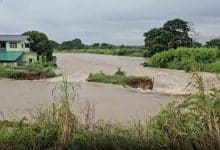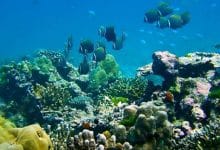Ang Thong park still positive amid worst coral bleaching in decades

Ang Thong National Marine Park is experiencing its most severe coral bleaching event in a decade, with conditions expected to improve by August. The park anticipates earning over 40 million baht in revenue by the end of the fiscal year.
Ang Thong National Marine Park is grappling with a significant coral bleaching crisis, its most severe case in the last decade. The situation has escalated due to rising sea temperatures, which have caused widespread coral stress and bleaching.
Head of Ang Thong National Marine Park, Sutin Prompalat reported that surveys conducted at 13 stations within the park revealed coral bleaching levels ranging from 40% to 75%. The bleaching began in April, with sea temperatures fluctuating between 29.19 and 32.36 degrees Celsius over three months, from April to June.
The high sea temperatures have placed corals under significant stress, leading to extensive bleaching. However, there is hope on the horizon as the sea temperature has begun to decrease. Sutin expressed optimism that the situation would improve by August.
The management of Ang Thong National Marine Park encompasses around 84 square kilometres (km2) of water and 18 km2 of land, spread across 42 islands.
Some of the notable islands include Phaluai Island, Wua Talap Island, Mae Ko Island, Sam Sao Island, Tai Plao Island, Wua Kantang Island, Hin Dap Island, and Phai Luak Island. The park is also a habitat for the Bryde’s whale, a protected species under Thai law.
Heritage park
Sutin highlighted the park’s excellent management practices, which have earned numerous accolades, including being certified as an ASEAN Heritage Park, the sixth in Thailand to receive this honour. It has also been designated as a Ramsar Site, recognising its importance as a wetland of international significance.
Other honours include the Thailand Tourism Silver Awards for natural attractions and the Green National Park Award for environmental management in 2016 and 2020.
Furthermore, the park management has undertaken various initiatives to ensure visitor safety and enhance tourist experiences. In April, staff were trained in emergency rescue operations, including CPR and responses to potential incidents such as kayak accidents, seafood allergies, and jellyfish stings. Special nets have been installed at Wua Talap Island to protect swimmers from Portuguese man-of-war jellyfish.
Regular upgrades and maintenance of tourist facilities are also in place, including the repair of guesthouses and the installation of additional fans. Daily beach clean-ups are conducted to maintain the pristine condition of the park.
Sutin mentioned that the park limits the number of tourists to 1,000 per day, with approximately 80% to 90% being international visitors. As of the current fiscal year, the park has already generated around 38 million baht in revenue.
Sutin confidently projected that the park’s revenue would surpass 40 million baht by the end of the fiscal year, positioning Ang Thong National Marine Park as the ninth highest-earning park among Thailand’s 156 national parks, reported KhaoSod.
Latest Thailand News
Follow The Thaiger on Google News:


























